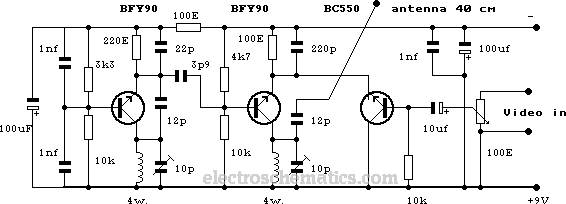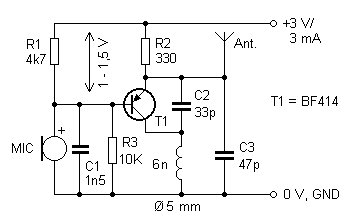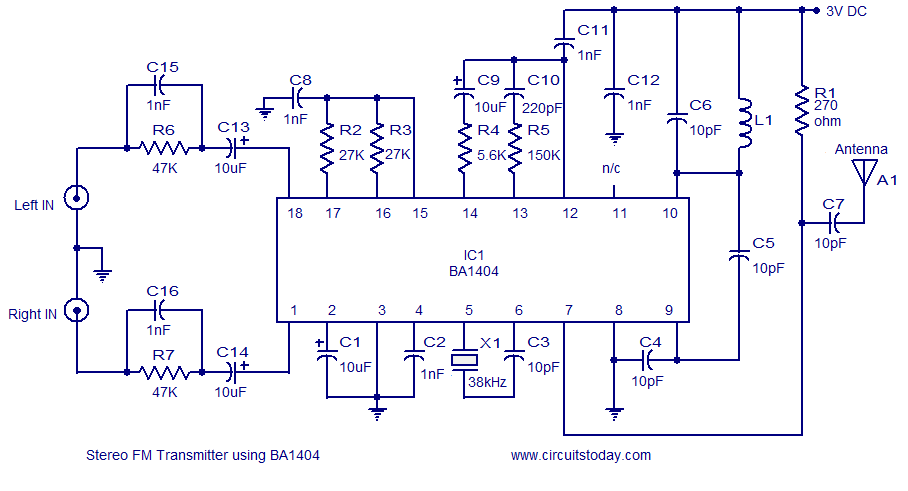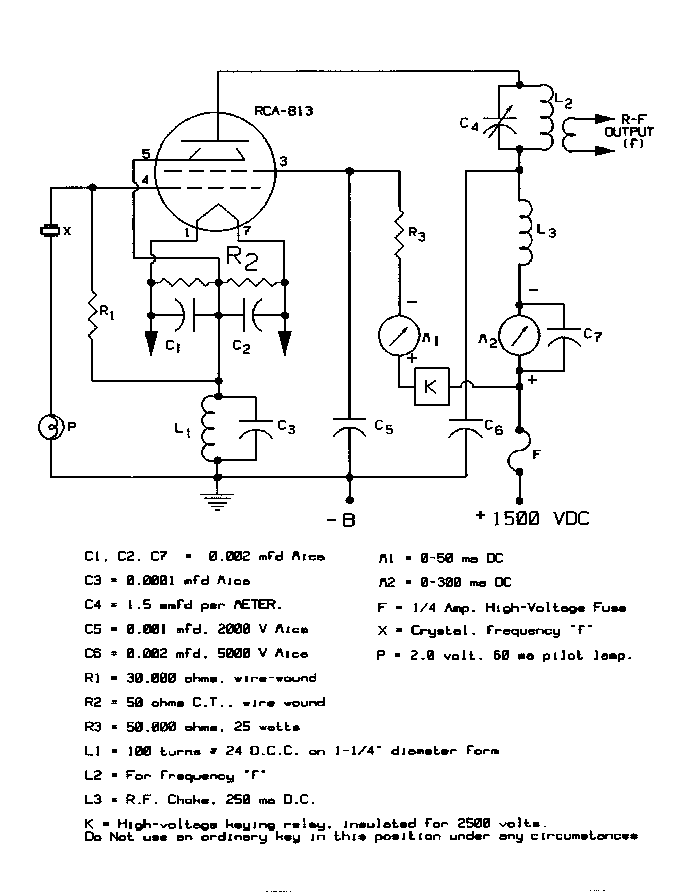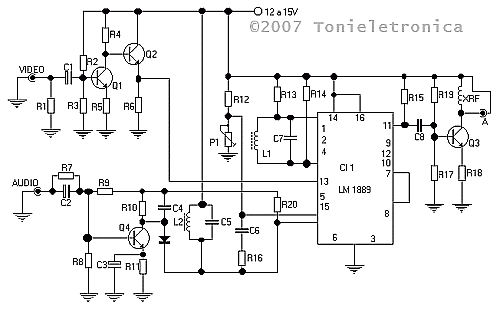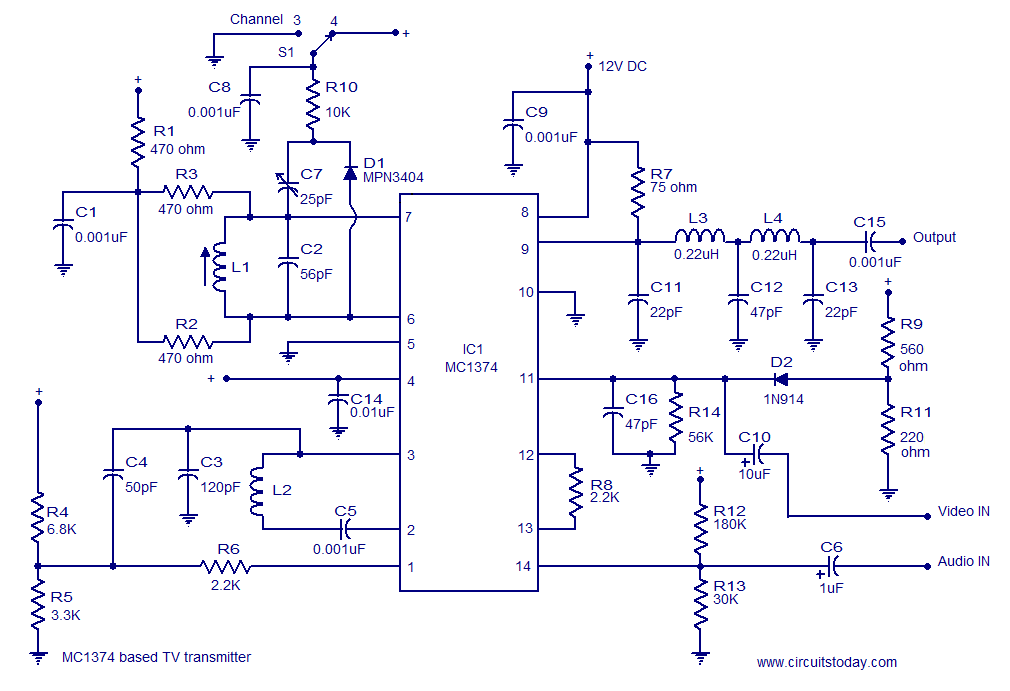
McCoy Mighty Midget Transmitter
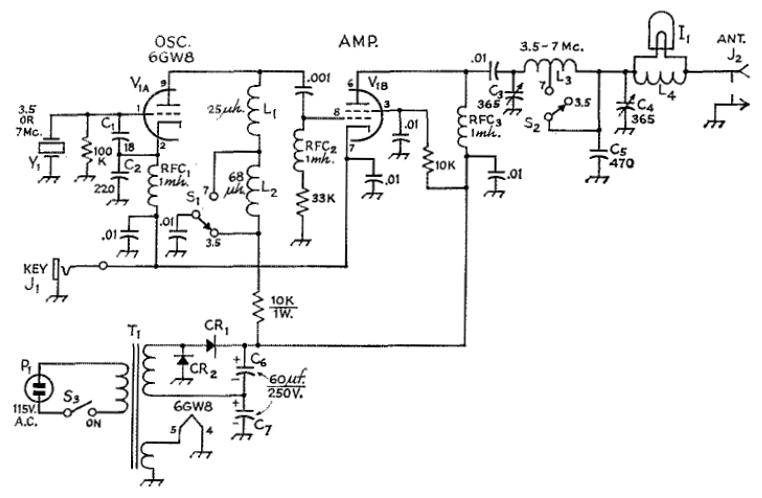
The circuit employs a 6GW8 triode-pentode in an oscillator-amplifier configuration that demonstrates an unconventional application of oscillator principles, coupled with a lack of attention to amplifier stability concerns. Consequently, this transmitter should not be replicated or operated without significant modifications to the circuit. The schematic of McCoy's "Mighty Midget" transmitter illustrates that the design's power amplifier (6GW8 pentode) lacks neutralization and incorporates frequency-tuned circuits in both its grid and plate circuits, making that stage a tuned-plate, tuned-grid oscillator. If fortunate, it may lock onto the frequency of its triode crystal oscillator and maintain stability. The issues with the Mighty Midget originate from its oscillator, which utilizes a common-anode triode Colpitts circuit. This circuit operates with its anode elevated above RF ground due to the inaccurately resonant circuit created by an RF choke (for 40 meters) or that RF choke in series with another choke (for 80 meters), in parallel with the capacitance to ground from the triode anode, pentode grid, and their connecting wires. The choice of the Colpitts configuration, the integration of oscillator-anode parallel resonance, and the inclusion of an RF choke in series with the power amplifier's grid-leak resistor—an approach largely outdated since the mid-1950s—indicates that McCoy aimed to rectify the underdrive issue experienced with the Boosted Pierce design. Eleven years prior, in the October 1955 issue of QST, he modified a commercial aperiodic-oscillator design to address this issue by adding oscillator-anode tuning and power-amplifier neutralization in "More Power with the AT-1." The presence of oscillator anode (amplifier grid) resonance, without the addition of amplifier neutralization, introduces a critical flaw: with the anode and grid tuned to approximately the same frequency by design, the high-gain pentode power amplifier becomes unstable, functioning more like a locked oscillator than a mere amplifier. Observations of hysteresis in the amplifier plate tuning at 40 meters suggest that this instability may be present; achieving a consistent peak output power proved challenging, with maximum output occurring at different settings when tuning through resonance from above and below. Disconnecting the cold end of the oscillator cathode choke from the KEY jack revealed that the Mighty Midget produced more RF power with the crystal oscillator disabled than when it was connected and operational. Adjusting the amplifier plate tuning across a broad range around resonance elicited various sounds in the receiver as the final amplifier oscillated through and rejected differing modes of oscillation, some exhibiting greater purity than others. Maintaining the key at the circuit's highest power output setting resulted in a relatively clean but highly unstable signal at approximately 7065 kHz, with proximity to the oscillator-anode chokes causing significant frequency fluctuations. The amplifier-oscillator combination produced chirping sounds when keyed on and off, indicating that this transmitter is unsuitable for beginners or novices. The experiences shared by the PI4RAZ club website administrator, presumably Frank Waarsenburg, PA3CNO, corroborate the problematic locked-oscillator nature of the design. An increase in the anode voltage to 300 V initiated instability, confirming that the tuned circuit in the triode's anode is linked to the grid circuit of the pentode. Ultimately, the transmitter generated more power with the crystal removed than with it in place.
The "Mighty Midget" transmitter circuit, characterized by its use of the 6GW8 triode-pentode, presents a unique amalgamation of oscillator and amplifier functionalities. The configuration is particularly noteworthy due to the inherent instability caused by the lack of neutralization, resulting in a design that behaves more like an oscillator than a traditional amplifier. The Colpitts oscillator, while popular due to its simplicity, introduces complexities when combined with the power amplifier stage, primarily due to the interaction between the tuned circuits. The RF choke's role in both the oscillator and amplifier circuits further complicates the design, as it can lead to unintended resonances and oscillatory behavior.
In practical applications, the design's sensitivity and instability can lead to unpredictable performance, particularly in terms of frequency stability and output power. The circuit's reliance on precise component values and tuning may limit its usability, especially for operators lacking advanced technical skills. The historical context of the design, including its evolution from earlier oscillator configurations and the attempts to address underdrive issues, highlights the challenges faced by engineers in achieving reliable RF amplification. The insights gained from operational testing, including the effects of varying anode voltage and the behavior of the circuit under different conditions, underscore the importance of thorough testing and modification before any practical deployment. Overall, while the "Mighty Midget" transmitter is an interesting study in oscillator-amplifier design, it serves as a cautionary example of the potential pitfalls in RF circuit design and the necessity for careful consideration of stability and performance factors.It uses a 6GW8 triode-pentode in an oscillator-amplifier design that combines a curious misapplication of oscillator fundamentals with insufficient attention paid to issues of amplifier stability. The result is a transmitter that shouldnot be duplicated and used on the air without considerable circuit modification.
Figure 1 ” Schematic of McCoy`s "Mighty Midget" transmitter. That the design`s power amplifier (6GW8 pentode) is not neutralized and includes operating-frequency-tuned circuits in its grid and plate circuits renders that stage a tuned-plate, tuned-grid oscillator that ”if you`re lucky ”locks to the the frequency of its triode crystal oscillator and stays there. The Mighty Midget`s troubles begin with its oscillator, a common-anode triode Colpitts circuit that nonetheless operates with its anode held above RF ground by the imprecisely resonant circuit formed by one RF choke (40 meters) or that RF choke plus another choke in series (80 meters) paralleled by the capacitance to ground of the triode anode and pentode grid and their interconnecting wiring.
The use of the Colpitts arrangement, the building-in of oscillator-anode parallel resonance, and the use of an RF choke in series with the power amplifier grid-leak resistor ”a usage more or less obsolete as of the mid-1950s ”suggest that in designing the Mighty Midget, McCoy had worked to avoid the power amplifier underdrive of the Boosted Pierce: Eleven years earlier, beginning on page 36 of October 1955 QST, he had modified an aperiodic-oscillator-based commercial design to overcome exactly that problem by adding oscillator-anode tuning and power-amplifier neutralization in "More Power with the AT-1. " The presence of oscillator anode (amplifier grid) resonance without the addition of amplifier neutralization results in a serious flaw: With its anode and grid tuned to roughly the same frequency by design, the transmitter`s high-gain pentode power amplifier is unstable to the point of acting more like a locked oscillator than just an amplifier.
Suspecting that this might be true with my version of the Mighty Midget after I encountered hysteresis in its amplifier plate tuning at 40 meters ”I couldn`t achieve the same output power peak, and maximum output occurred at different settings, when tuning through resonance from above and below resonance ”I disconnected the cold end of the oscillator cathode choke from the KEY jack and discovered that the Mighty Midget put out more RF power with its crystal oscillator disabled than with its crystal oscillator connected and operating! Adjusting the amplifier plate tuning across a wide range below, through, and above resonance and back again, I heard a series of grunts and squawks in my receiver as the final amplifier found and rejected varying modes of oscillation, some purer than others.
Holding my key down at the circuit`s highest power output setting, I discovered a relatively pure but highly frequency-unstable signal at about 7065 kHz. Moving a hand near the oscillator-anode chokes swung the frequency wildly. Keyed on and off, the amplifier-cum-oscillator chirped like the proverbial bird. This is a transmitter suitable for neither beginner nor Novice. Writing of his own experiences with the Mighty Midget, the PI4RAZ club website administrator ”who, if I have inferred from my drillings-down correctly, is Frank Waarsenburg, PA3CNO ”confirms the hazardous locked-oscillator nature of its design: When I increased the anode voltage to 300 V, the fight began.
David Newkirk was right. The tuned circuit in the anode of the triode is in the grid circuit of the pentode! I had actually built a crystal-oscillator-synchronized TPTG (tuned plate, tuned grid) oscillator. The transmitter put out more power with the crystal removed than with the crystal in place. (transl 🔗 External reference
The "Mighty Midget" transmitter circuit, characterized by its use of the 6GW8 triode-pentode, presents a unique amalgamation of oscillator and amplifier functionalities. The configuration is particularly noteworthy due to the inherent instability caused by the lack of neutralization, resulting in a design that behaves more like an oscillator than a traditional amplifier. The Colpitts oscillator, while popular due to its simplicity, introduces complexities when combined with the power amplifier stage, primarily due to the interaction between the tuned circuits. The RF choke's role in both the oscillator and amplifier circuits further complicates the design, as it can lead to unintended resonances and oscillatory behavior.
In practical applications, the design's sensitivity and instability can lead to unpredictable performance, particularly in terms of frequency stability and output power. The circuit's reliance on precise component values and tuning may limit its usability, especially for operators lacking advanced technical skills. The historical context of the design, including its evolution from earlier oscillator configurations and the attempts to address underdrive issues, highlights the challenges faced by engineers in achieving reliable RF amplification. The insights gained from operational testing, including the effects of varying anode voltage and the behavior of the circuit under different conditions, underscore the importance of thorough testing and modification before any practical deployment. Overall, while the "Mighty Midget" transmitter is an interesting study in oscillator-amplifier design, it serves as a cautionary example of the potential pitfalls in RF circuit design and the necessity for careful consideration of stability and performance factors.It uses a 6GW8 triode-pentode in an oscillator-amplifier design that combines a curious misapplication of oscillator fundamentals with insufficient attention paid to issues of amplifier stability. The result is a transmitter that shouldnot be duplicated and used on the air without considerable circuit modification.
Figure 1 ” Schematic of McCoy`s "Mighty Midget" transmitter. That the design`s power amplifier (6GW8 pentode) is not neutralized and includes operating-frequency-tuned circuits in its grid and plate circuits renders that stage a tuned-plate, tuned-grid oscillator that ”if you`re lucky ”locks to the the frequency of its triode crystal oscillator and stays there. The Mighty Midget`s troubles begin with its oscillator, a common-anode triode Colpitts circuit that nonetheless operates with its anode held above RF ground by the imprecisely resonant circuit formed by one RF choke (40 meters) or that RF choke plus another choke in series (80 meters) paralleled by the capacitance to ground of the triode anode and pentode grid and their interconnecting wiring.
The use of the Colpitts arrangement, the building-in of oscillator-anode parallel resonance, and the use of an RF choke in series with the power amplifier grid-leak resistor ”a usage more or less obsolete as of the mid-1950s ”suggest that in designing the Mighty Midget, McCoy had worked to avoid the power amplifier underdrive of the Boosted Pierce: Eleven years earlier, beginning on page 36 of October 1955 QST, he had modified an aperiodic-oscillator-based commercial design to overcome exactly that problem by adding oscillator-anode tuning and power-amplifier neutralization in "More Power with the AT-1. " The presence of oscillator anode (amplifier grid) resonance without the addition of amplifier neutralization results in a serious flaw: With its anode and grid tuned to roughly the same frequency by design, the transmitter`s high-gain pentode power amplifier is unstable to the point of acting more like a locked oscillator than just an amplifier.
Suspecting that this might be true with my version of the Mighty Midget after I encountered hysteresis in its amplifier plate tuning at 40 meters ”I couldn`t achieve the same output power peak, and maximum output occurred at different settings, when tuning through resonance from above and below resonance ”I disconnected the cold end of the oscillator cathode choke from the KEY jack and discovered that the Mighty Midget put out more RF power with its crystal oscillator disabled than with its crystal oscillator connected and operating! Adjusting the amplifier plate tuning across a wide range below, through, and above resonance and back again, I heard a series of grunts and squawks in my receiver as the final amplifier found and rejected varying modes of oscillation, some purer than others.
Holding my key down at the circuit`s highest power output setting, I discovered a relatively pure but highly frequency-unstable signal at about 7065 kHz. Moving a hand near the oscillator-anode chokes swung the frequency wildly. Keyed on and off, the amplifier-cum-oscillator chirped like the proverbial bird. This is a transmitter suitable for neither beginner nor Novice. Writing of his own experiences with the Mighty Midget, the PI4RAZ club website administrator ”who, if I have inferred from my drillings-down correctly, is Frank Waarsenburg, PA3CNO ”confirms the hazardous locked-oscillator nature of its design: When I increased the anode voltage to 300 V, the fight began.
David Newkirk was right. The tuned circuit in the anode of the triode is in the grid circuit of the pentode! I had actually built a crystal-oscillator-synchronized TPTG (tuned plate, tuned grid) oscillator. The transmitter put out more power with the crystal removed than with the crystal in place. (transl 🔗 External reference
